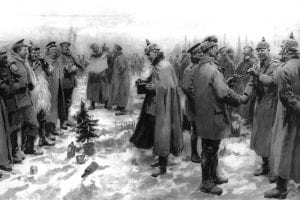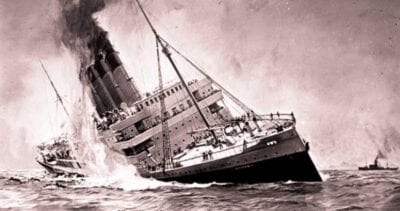On the 24th April 1915, The Ottoman Empire announced that Christian Armenians (now Modern Turkey (99.8% Muslim according to CIA’s World Fact Book) would be deported to the interior. Nearly 1.5 million Armenian deaths occurred during the forced marches. Although the marches were ostensibly for the purpose of protecting the Armenians through relocation, the actual purpose was to make the marches so difficult (for example, by not providing any food) that survival was impossible.
The announcement came while the Ottoman government was desperately afraid of an Allied attack that would turn Turkey’s war against Russia into a two-front war. In fact, British troops landed at Gallipoli in western Turkey the next day. Although the Anglo-Russian offensives failed miserably, the Armenian genocide continued for the next two years. [8] Some of the genocide was accomplished by shooting or cutting down Armenian men. The bulk of the 1 to 1.5 million Armenian deaths, however, occurred during the forced marches to the interior. Although the marches were ostensibly for the purpose of protecting the Armenians through relocation, the actual purpose was to make the marches so difficult (for example, by not providing any food) that survival was impossible.
Armenian Gun Control
Feb 1915, Local officials in each Armenian district were ordered to surrender quotas of firearms. When officials surrendered the required number, they were executed for conspiracy against the government. When officials could not surrender enough weapons from their community, the officials were executed for stockpiling weapons. Armenian homes were also searched, and firearms confiscated. Many of these mountain dwellers had kept arms despite prior government efforts to disarm them. (Simkin et al., supra note 2, at 82.)
Although many Armenians apparently complied with the gun control laws and the deportation orders, some did not. For example, in southern Syria (then part of the Ottoman Empire), “the Armenians refused to submit to the deportation order . . . . Retreating into the hills, they took up a strategic position and organized an impregnable defense. The Turks attacked and were repulsed with huge losses. They proceeded to lay siege.” [10] Eventually 4,000 survivors of the siege were rescued by the British and French. These Armenians who grabbed their guns and headed for the hills are the converse to the vast numbers of Armenian and other genocide victims in Lethal Laws who submitted quietly; although many of the Armenian fighters doubtless died from lack of medical care, starvation, or gunfire, so did many of the Armenians who submitted. As was the case of the Jewish resistance during World War II, armed resistance was enormously risky, but the resisters had a far higher survival rate than the submitters.
French Rothschild Branch Behind the Planned Genocide Of Armenians
The plans of the 1915-23 Armenian Genocide, where a million and half Armenians perished in a barbaric way in their ancestral lands in modern Turkey, actually were drawn up and were in place by the year 1910 or 1912.
There is the book “Inner Folds of the Ottoman Revolution” written by Mevlan Zadeh Rifat in Turkish and published in 1929, the author, a pro-sultan Turk, claims that the “Armenian genocide was decided in August 1910 and October 1911, by a Young Turk committee composed entirely of displaced Balkan Jews in the format of a syncretist Jewish-Muslim sect which included Talaat, Enver, Behaeddin Shakir, Jemal, and Nizam posting as Muslims. It met in the Rothschild-funded Grand Orient loge/hotel of Salonika.” Syncretism means a combination of different forms of belief or practice; masonism fits that description. As the masons started the 1897 revolution in France with the cry “liberty, fraternity, equality,” Young Turks used the same slogan in their revolution of 1908.
A 1994 conference paper/lecture by Joseph Brewda of Schiller Institute entitled “Palmerson launches Young Turks to permanently control Middle East ” claims the founder of the Young Turks to be a certain Jew by the name of Emmanuel Carasso. He states: “Carasso set up the Young Turk secret society in the 1890s in Salonika, then part of Turkey, and now part of Greece. Carasso was also the grand master of an Italian masonic lodge there, called ‘Macedonia Resurrected.’ The lodge was the headquarters of the Young Turks, and all the top Young Turk leadership were members.”
Further on Mr. Brewda says: “During the Young Turk regime, Carasso continued to play a leading role. He met with the sultan, to tell him that he was overthrown. He was in charge of putting the sultan under house arrest. He ran the Young Turk intelligence network in the Balkans. And he was in charge of all food supplies in the empire during World War I.” It is ironic that four centuries after the Turkish sultans welcomed the expelled European Jews into Turkey, certain Jews belonging to secret societies and to Zionism will kick the sultan out of power early in 20th century, destroy the Ottoman Empire, and celebrated their victory by massacring by proxy almost the whole Christian Armenian people, one million and half Armenians; half million Greeks; and half million Christian Assyrians & Arameans.
All this according to the percepts of the Talmud, the Satanic Bible of the Talmudic Jews, which encourages Jews to kill, directly or indirectly, by sayings like: “Every Jew who spills the blood of the godless, is doing the same as making a sacrifice to God.” Talmud: Bammidber Raba c21 & Jalkut 772. In the eyes of Talmudists all non-Jews are godless. And “It is the law to kill anyone who denies the Torah. The Christians belong to the denying ones of the Torah.” Talmud: Coschen Hamischpat, Hagah 425. Very neatly put sentence indeed.
Back to the Young Turks. Mr. Brewda writes: “Another important area was the press. While in power, the Young Turks ran several newspapers, including ‘The Young Turk,’ whose editor was none other than the Russian Zionist leader Vladimir Jabotinsky. Jabotinsky had been educated as a young man in Italy.”
Mr. Brewda, ignoring the possibility that Talaat could have been a secret infiltrated Jew, writes: “Of course, there were also some Turks who helped lead the Young Turk movement. For example, Talaat Pasha. Talaat was the interior minister and dictator of the regime during World war I. He had been a member of Carasso’s Italian masonic lodge in Salonika. One year prior to the 1908 coup, Talaat became the grand master of the Scottish Rite Masons in the Ottoman Empire. If you go to the [archives of] Scottish Rite headquarters in Washington, D.C., you can find that most of the Young Turk leaders were officials in the Scottish Rite.”
In Istanbul, which was the capital and the power center of the Ottoman Empire, there was only few thousands (less than 10,000) Jews and some 200,000 Armenians and Greeks who controlled the trade, finances and arts of the Empire. Jews and Christians were in strong competition through hundreds of years of the life of the empire. Jews were the losers and Christians were the winner always because the Sultans ( there were very few bad sultans who killed Christians) listened to and favored the Christians. For the Zionist Jews to take over Turkey, its Christians had to be eliminated; and that is another ugly facade of the first Genocide of the 20th Century in Turkey.
Another source is the lengthy article “The Armenian & Jewish Genocide Project: Eliminating Ethnic Conflict Along the Oil Route From Baku to the Suez Canal Region” written by Clifford Shack and posted in his web-site. Mr. Shack writes: “In the 1880’s, the French branch of the Rothschild family acquired interests in Russia’s Baku oil fields in an effort to supply their refinery on the Adriatic with cheap Russian oil. In exchange for these interests they built a railroad linking Baku to the newly acquired Black Sea port of Batum. This opened up the Baku oil, a major world supply, to the world. With the success of the new railroad, the Rothschilds had more oil than they could actually sell. Overcoming their fear of competing with the giant Standard oil [of USA], they sought out the huge [Far East] markets east of Suez.”
Further on Mr. Shack makes his point: “The decision by the shrewd French Rothschild branch to diversify into other areas of oil exploitation was, presumably, a calculated one. Three years after they joined Royal Dutch, production at Baku would come to an abrupt halt in 1905. Although shaken by political activity, the principal disruption was due to the violence of the ethnic conflict between the region’s Muslims and the minority population of Armenians who are Christians. This ethnic conflict caused the first interruption of oil distribution to the world market. Standard oil was quick to supplant the needs of the effected markets as its source was operating under the blanket of peace. The Royal/Dutch/Shell Group (and the Nobles) watched their Baku investments go up in flames. Ethnic conflict was at the root of the matter. It could be safely assumed that they were taking measures to eliminate the possibility of that happening in the future.” Oil corporations seem to have learned their lessons from history because before the construction of present-day Baku-Ceyhan pipeline has began, someone has made sure that no Armenians were left in Baku anymore. Mr. Shack notes that “the mere elimination of the Armenian population of Baku would not solve the problem of ethnic conflict in that region. The surrounding areas would provide reservoir effect in resupplying the conflicting minority element.” And he asks: “was the removal [in 1915-23] of a small minority like the Armenians [from historical Armenia] a fair price to pay for the peace in a region so crucial to the development and investment of the Far East?” Apparently Mr. Shack ignores the factor of revenge raging in the heart of human beasts.
Mr. Shacks answers his own question by stating in his article about the big business or big corporations: “It would be fair to say that the genocide of a group of a million or so, to serve the benefit of a billion or so [in the Far East], is less of a question of should it be done, than how it could be done. So as not to reveal any plausible motive which could link the actual planners to the genocide, the scheme involved a proxy party [namely the Muslim Turks, Kurds & Azeris] , which was manipulated through layers of influence, providing sufficient cover for the planners.”
From <http://rense.com/general64/genoc.htm>
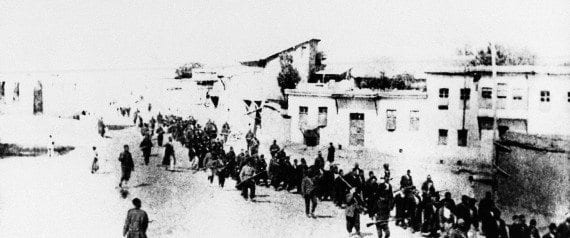
On April 24, 1915, Ottoman Turkish authorities hauled off Daniel Varoujan, a leading Armenian poet of the time, along with over 200 other intellectuals in the capital Constantinople. To the crumbling Ottoman Empire, the poets, painters, writers, booksellers and politicians at the beating heart of the Armenian community posed too much of a threat. Soon, much of the empire’s Christian Armenian population would be targeted and nearly wiped out, accused of conspiring against the empire with the Russians. Many Armenians say the genocide was collective punishment for the actions of a few.
In August, after a wave of deportations began that would force hundreds of thousands of Armenians on brutal death marches toward the Syrian desert, Varoujan was tortured to death, according to eyewitnesses at the time. Varoujan was just one of many men, women and children who lost their lives. 100 years later in April 2015, Armenians from around the world gathered in Istanbul to commemorate the deaths of nearly 1.5 million Armenians who died in what would later be known by many — but not by Turkey, the United States and some other countries — as the Armenian Genocide. A century on, the killings are hardly a thing of the past, with sensitive geopolitics still fueling the controversy.
Regardless of how it’s labeled, here are some figures that explain the size and scope of this tragedy:

1.5 million
The number of Armenians believed to have been killed between 1915 and 1917.
“Rape and beating were commonplace,” wrote acclaimed historian David Fromkin in his Pulitzer Prize-winning book on the Ottoman Empire’s downfall, A Peace to End All Peace. “Those who were not killed at once were driven through mountains and deserts without food, drink or shelter. Hundreds of thousands of Armenians eventually succumbed or were killed.”
An Armenian man in Istanbul, who as a schoolboy discovered his family was Armenian, told The WorldPost one story passed down to him by his parents: His grandfather, too exhausted to walk any farther in the death march toward the Syrian desert, refused to go on. He would rather drown than walk another mile to his death, he told the Turkish Ottoman guards. And so, the man says, they held his grandfather under the water until he was dead.
250
The number of intellectuals reportedly rounded up by Ottoman Turks on April 24, 1915, in Constantinople (now Istanbul), kicking off what would become a massive wave of arrests, deportations and killings. Many of these Armenians were later deported and in many cases killed. Armenians commemorate the anniversary of the Armenian Genocide every year on April 24.
“They took the intellectuals, the cream of the crop,” one Armenian book publisher who said his father, a baker, lived in Constantinople when the arrests took place, recently told The WorldPost. “They took the head and left the body.”
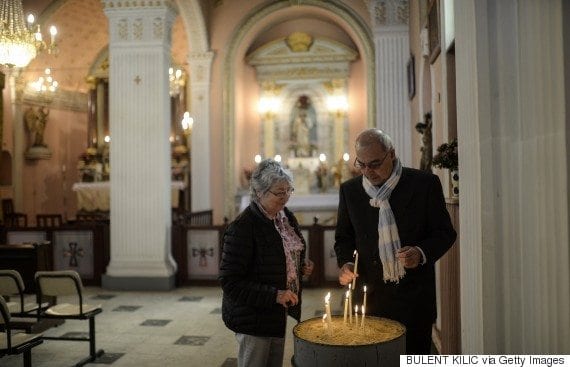
60,000
The number of dead bodies reportedly found in 1916 in a mass grave in Maskanah, a northern town in what is now modern day Syria, according to Jesse B. Jackson, U.S. consul in Aleppo. “As far as the eye can reach mounds are seen containing 200 to 300 corpses buried in the ground,” he said in a cable to Washington.
300,000
The number of Armenians who died during this period due to war and disease, according to Turkey, which vehemently denies the 1.5 million figure.
“According to independent researchers, 300,000 Armenians lost their lives because of the war and disease,” reads one Turkish state-provided textbook for high school students. “But during that time, Armenians killed 600,000 Turks and forced 500,000 Turks to leave their land.”
2,133,190
The number of Armenians living in the Ottoman empire before 1914, according to the University of Minnesota’s Center for Holocaust and Genocide Studies.
387,800
The number of Armenians still left in the Ottoman Empire in 1922.

20
The number of nations that officially recognize the Armenian Genocide. The list does not include the United States, Israel and many others who on the centenary are grappling with labeling the killings a genocide. Germany is expected to finally do so on the anniversary.
The Armenian Genocide still remains one of the most bitterly contested events in history, especially for Turkey, fiercely defensive of its Ottoman past.
The White House doesn’t want to use the fateful “g” word because it would anger the wrong people.
That’s essentially what the Obama administration officials said in 2015 (prior to the 100th anniversary) when faced with increasing pressure to label the mass killings a genocide. Citing “regional priorities” in its decision not to say the killings amounted to genocide, the U.S. government insisted it would urge “a full, frank, and just acknowledgment of the facts,” according to a White House statement.
The decision angered many Armenians in the United States and abroad who say they had hoped President Barack Obama would use the centennial as an opportunity to put things right, considering his track record of acknowledging the genocide prior to assuming the presidency.
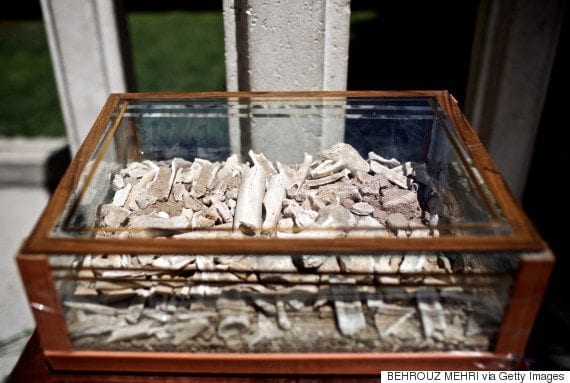
There was real concern in Turkey that legal ramifications of calling the 1915 massacres a “genocide” could lead to costly reparations.
In a column in the Daily Sabah, a Turkish newspaper known for its staunchly pro-government rhetoric, one columnist wrote that the genocide claimed by Armenians is just a ruse by the Armenian diaspora and descendants in Turkey to tear apart the country and take over Turkish territory.
While Turkey in recent years has taken more conciliatory steps towards addressing the killings of Armenians, with Turkish President Recep Tayyip Erdogan making what was considered to be a groundbreaking 2014 speech in which he offered condolences to the descendants of those killed, tempers have recently flared.
With the lead-up to the 100-year anniversary, Turkey has furiously defended itself from genocide claims, lashing out at the Pope and the European Parliament for their views on what is widely seen as a systematic slaughter.
“Concealing or denying evil is like allowing a wound to keep bleeding without bandaging it,” Pope Francis said earlier this month after calling the killings the first genocide of the 20th century. Ankara then recalled its ambassador from the Vatican.
Turkey’s Erdogan dismissed the genocide debate, just as the European Parliament voted on April 15 to call the events of 1915 a genocide. Prior to the 2015 anniversary, Turkey said it was pulling its ambassador to Austria over the debate.
While Turkey acknowledges that some Armenians died — calling them casualties of war, disease and chaos of the time — the state says that since the deaths were not methodically planned to wipe out Armenians, it does not add up to genocide. “It is out of the question for there to be a stain, a shadow called ‘genocide,’ on Turkey,” Erdogan said last week.
From <http://www.huffingtonpost.com/2015/04/23/armenian-genocide-controversy_n_7121008.html>
https://www.youtube.com/watch?v=WLyrpaTKCCE
Additional Resources:

